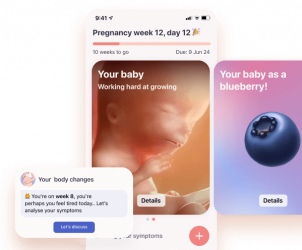

Femia > IVF due date calculator
IVF due date calculator
The Pregnancy weight gain calculator estimates a schedule for healthy weight gain based on guidelines from the Institute of Medicine


Femia app helps you stay on track, stress-free!
Femia helps you stay on track, stress-free!
- Updated Feb 25, 2025
- Published
CRAFTED BY HUMAN
Crafted by human At Femia, we provide accurate and up-to-date information at every stage of your journey, from trying to conceive, pregnancy and postnatal support. All content is created by a real person based on in-depth research and own professional experience. Femia ensures that you will receive expert advice, strict accuracy and a personalized approach from our authors/medical experts. Learn more about our editorial policy.
FACT CHECKED
Fact checked At Femia Health, we maintain the highest standards of editorial excellence in delivering content focused on helping you conceive, guiding you through pregnancy, and supporting you postpartum. Explore our content review principles to learn how we ensure the accuracy and quality of our health and lifestyle tips for every stage of your journey.
IVF & FET due date calculator
Using an IVF or FET due date calculator is an easy and accurate way to estimate the predicted labor date based on your transfer date and the embryo’s development stage. Using them is important to inform and guide your prenatal care and ensure you’re prepared for labor.
What are IVF & FET due date calculators?
An IVF pregnancy calculator is a special tool designed to help expectant mothers calculate their estimated delivery date for pregnancies achieved through in vitro fertilization (IVF) treatment.
A FET due date calculator, in turn, is a tool that calculates the expected delivery date for pregnancies achieved through the frozen embryo transfer (FET).
Both an IVF due date calculator and FET calculator are meant to give mothers-to-be some peace of mind and help them better prepare for labor. These calculators estimate your due date based on your unique data, such as:
- The date of embryo transfer
- The type of transfer
Using this information, calculators can predict the estimated due date based on typical IVF and FET cases.
👉Find out more: Implantation bleeding vs period: How to tell the difference
How to use an IVF due date calculator
If your pregnancy was achieved through in vitro fertilization, the IVF calculator due date is a tool that will help you predict the expected labor date. Here’s how you can use it based on your unique situation:
IVF due date calculator 3-day transfer
- Indicate the specific date of embryo transfer.
- Pick “Day 3” as a transfer type.
- Click “Calculate”.
IVF due date calculator 5-day transfer
- Indicate the transfer date.
- Pick “Day 5” as a transfer type.
- Click “Calculate”.

What other ways can you calculate your IVF due date?
Apart from using an IVF pregnancy calculator, you can calculate your due date manually, by following these instructions:
- If you had a 3-day embryo transfer, add 263 days to the date of transfer to get an estimated labor date.
- If you had a 5-day embryo transfer, add 261 days to the date of transfer to get an estimated labor date.
- If you had an embryo transfer later than five days, simply subtract the number of days from 266 and add the received number to your transfer date.
What is ICSI, and will it affect my due date?
Traditionally, in order for fertilization to happen, the head of the sperm needs to attach to the outer edge of the egg and enter it to form an embryo. In some cases, this process doesn’t happen naturally as the sperm cannot get through the egg’s outer layer.
This can happen due to lowered sperm motility or egg thickness. Regardless of the reason, IVF treatment allows you to overcome this with the help of the procedure known as intracytoplasmic sperm injection (ICSI).
In this process, the sperm is injected directly into the egg to assist fertilization. However, although ICSI impacts fertilization, it has no effect on your pregnancy’s due date because only the date of fertilized egg transfer matters in calculating it.
👉Find out more: Top foods to fight nausea during pregnancy: A first trimester survival guide
How to use an FET due date calculator
Calculating the frozen embryo transfer due date is also easy:
- Indicate the specific date of your transfer.
- Select the embryo stage at the time of the transfer (e.g. day 3, day 5, or another).
- Review your estimated due date.
In case you’re wondering why you have to indicate the stage of the embryo and the transfer date to predict your FET transfer due date, the thing is that this data serves as a reference for your “conception” date. In FET treatment, an embryo is transferred to your body at a specific stage of development. Respectively the stage of embryo and transfer date help define when conception took place and calculate the approximate due date based on this information.
Why are the due dates for a Frozen Embryo Transfer Day 5, Day 6, and Day 7 the same?
On days five, six, and seven, an embryo (under normal development conditions) is at its blastocyst stage–it is a ball of cells that are rapidly dividing. By letting an embryo reach this stage, FET clinics can find and pick an embryo with the highest likelihood of success, which is why due dates don’t differentiate as they all are defined by frozen embryo transfers at the blastocyst stage.
Femia offers the most accurate tool for tracking your health indicators during pregnancy
Differences between IVF and FET calculations
The core difference between IVF and FET cycles is the time when embryo transfer takes place:
- In a fresh IVF cycle, the best-quality embryo is transferred soon after egg retrieval, typically on day 3 or 5. Since the fertilization is done in a laboratory right after retrieval, the due date calculation begins on the day of egg retrieval.
- In a FET cycle, your embryos are frozen and then transferred when the embryo’s development stage and your body’s ability to implant an embryo are best aligned. Hence, the due date calculation depends on the date of the transfer and the embryo’s development stage (e.g. day 3 or day 5).
Are IVF and FET babies usually early or late?
The typical period of gestation is 40 weeks, with any labor that takes place before week 37 considered preterm. However, expectant mothers who have gone through IVF tend to deliver a bit earlier. Many IVF pregnancies result in labor in week 38, with the typical range between weeks 37 and 39, which is considered normal. Moreover, most IVF pregnancies are being more carefully monitored by doctors, which enables you and your healthcare provider to define the safety period for early delivery. So generally, if you find your IVF 3 day or 5 day embryo transfer due date to be shorter than 40 weeks, it’s okay.
As for FET cycles, the situation tends to be quite the opposite. According to studies, frozen embryo transfer tends to result in greater gestational age at birth and greater birth weight compared to fresh transfer. To be more specific, FET pregnancies tend to have labor in week 39, with the typical range between weeks 38 and 40.
👉Find out more: First trimester pregnancy diet: 1 to 3-month pregnancy diet chart and meal plans
Accuracy of IVF & FET due date calculators
Using an IVF FET due date calculator is a good way to predict your approximate date of labor and prepare for it. The accuracy of the calculation depends mostly on the accuracy of the data you input, such as the transfer date and the age of the embryo.
Generally, the IVF and FET due date estimations are considered to be more accurate compared to natural pregnancies because they imply that the exact time of fertilization is known. Still, it’s important to think about the results shown in an IVF or FET calculator as an informed guess and a window of time when you’re the most likely to go into labor, though you don’t have a 100% guarantee to give birth on that specific day.
Questions from the Femia community
Can the due date change after the initial calculation with an IVF or FET calculator?
The due date assigned after using an IVF or FET calculator is typically based on the embryo’s age and the date of the embryo transfer. This due date is usually determined by your fertility specialist and does not change based on ultrasound findings or the baby's growth patterns during pregnancy. However, it’s still essential to attend all recommended prenatal visits to monitor your health and the development of your pregnancy, ensuring you receive the best care possible.
Why is it important to know the exact type of embryo transfer (e.g., 3-day vs. 5-day)?
The type of embryo transfer stands for its development stage. A 3-day embryo is younger, whereas a 5-day embryo is already more developed and is closer to implantation. This development stage of an embryo can impact the estimated gestational age.
Are there any risks associated with using an IVF or FET due date calculator?
No, using these calculators is absolutely safe and risk-free. Both an IVF due date calculator and frozen transfer calculator are designed to help you inform and guide prenatal care and gain more clarity on the expected time of labor. Nevertheless, proper prenatal planning should always be supplemented with regular medical check-ups and consultations with your healthcare provider.
The bottom line
One of the specs of IVF and FET pregnancies is that the egg’s fertilization process is more controlled than in natural pregnancies, which allows one to know the exact date of fertilization and, respectively, calculate a labor date more accurately.
With a FET or IVF calculator, estimating your due date is easy and intuitive, while also accurate. All you need is to pick a calculator that suits you and input the relevant data, such as the embryo’s development stage, the transfer date, and voila – you have an approximate labor date.
Feel free to use these tools as an opportunity to inform your prenatal care. But don’t forget to complement it with regular check-ups and personalized care from your doctor!
References
- “In vitro fertilization (IVF).” Mayo Clinic, 1, Sept. 2023. https://www.mayoclinic.org/tests-procedures/in-vitro-fertilization/about/pac-20384716#:~:text=During%20in%20vitro%20fertilization%2C%20eggs,into%20the%20uterus%20(C).
- “Frozen Embryo Transfer Cycle. What you need to know.” UW Medicine, Feb. 2011. https://www.uwmedicine.org/sites/stevie/files/2018-11/Frozen-Embryo-Transfer-Cycle.pdf.
- “Intracytoplasmic Sperm Injection (ICSI).” Cleveland Clinic, 1, Mar. 2022. https://my.clevelandclinic.org/health/treatments/22463-intracytoplasmic-sperm-injection.
- “Blastocyst.” Mayo Clinic. https://www.mayoclinic.org/tests-procedures/in-vitro-fertilization/multimedia/blastocyst/img-20008646#:~:text=Three%20days%20after%20fertilization%2C%20a,that%20nourish%20and%20protect%20it.
- “WHAT WEEK ARE MOST IVF BABIES BORN, AND 11 OTHER IVF FAQS, ANSWERED.” LA IVF, 11, Aug. 2023. https://laivfclinic.com/blog/what-week-are-most-ivf-babies-born-and-11-other-ivf-faqs-answered/#:~:text=That%20being%20stated%2C%20those%20who,the%2038th%20week%20of%20gestation.
- Yu-Yang Hsiao, Che-Min Chen, Yu-Chen Chen, Ni-Chin Tsai, Yu-Ting Su, Yi-Ling Li, Kuo-Chung Lan. “High birth weight and greater gestational age at birth in singletons born after frozen compared to fresh embryo transfer.” Taiwanese Journal of Obstetrics and Gynecology, Volume 62, Issue 1, 2023. https://www.sciencedirect.com/science/article/pii/S1028455922003436.






